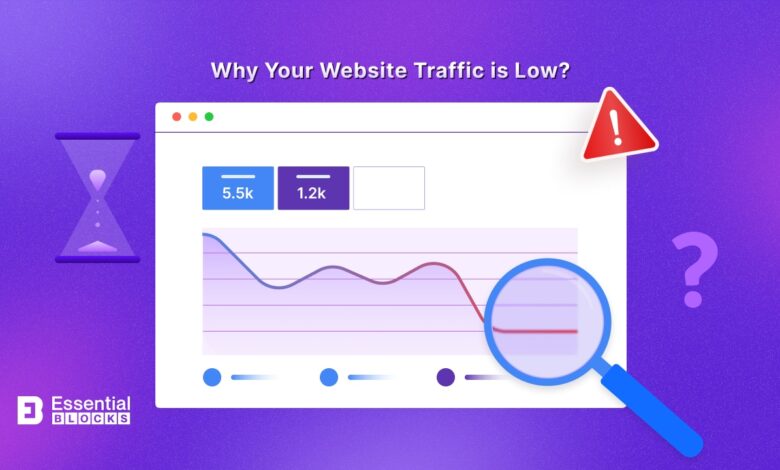
My Website Traffic Is Going Down What to Do
My website traffic is going down, and I’m worried. This isn’t just a minor dip; it’s a serious concern for my business. From potential algorithm changes to issues with my website design, this post delves into the various factors that could be causing this decline. We’ll analyze the data, pinpoint underperforming areas, and discuss strategies for improvement, from optimizing content to revamping my marketing approach.
Understanding the reasons behind declining traffic is crucial. This investigation explores common causes, from technical glitches to shifts in user behavior. We’ll use data analysis to understand where the problems lie and develop targeted solutions. Get ready to uncover the root causes and start regaining your online visibility.
Website Traffic Declines
Website traffic is a crucial metric for any online business. A drop in traffic can significantly impact revenue, brand visibility, and overall success. Understanding the potential causes behind these declines is essential for taking corrective action and restoring growth. This analysis explores various factors that might be contributing to a decrease in visitor numbers.Declining website traffic is a multifaceted problem.
It’s not always a single issue; often, a combination of factors contributes to the decline. Identifying these factors is the first step toward developing an effective strategy to reverse the trend.
Potential Causes of Website Traffic Decreases
Website traffic can decline due to a multitude of factors. Understanding these reasons is key to effectively addressing the issue and regaining visitor numbers.
- Algorithm Changes: Search engine algorithms are constantly evolving. Changes in ranking factors can significantly impact a website’s visibility in search results. For instance, Google’s frequent updates to its algorithm can cause a sudden drop in traffic for websites that are not optimized for the latest criteria. A website that previously ranked highly might now appear lower in search results, leading to fewer organic visitors.
- Competitor Activity: Increased competition can lead to a decrease in traffic. If competitors launch aggressive marketing campaigns or improve their website optimization, they may attract more visitors and take away market share. Observing competitors’ strategies and adapting to them is vital for maintaining website traffic.
- Seasonal Trends: Website traffic often fluctuates based on seasonal trends. Certain industries or niches may experience higher traffic during specific times of the year, such as holidays or promotional periods. Knowing these seasonal patterns is important to understand the fluctuations and adjust marketing efforts accordingly.
- Website Design and Functionality: A poorly designed or dysfunctional website can negatively impact user experience. Slow loading times, confusing navigation, or difficult-to-use features can deter visitors and decrease engagement. A user-friendly website design is critical for attracting and retaining visitors.
- Content Quality: The quality of website content plays a vital role in attracting and retaining visitors. Poorly written, outdated, or irrelevant content can lead to decreased engagement and traffic. High-quality, relevant content that provides value to visitors is essential for attracting and retaining them.
- Technical Glitches, Server Problems, and Security Breaches: Technical issues such as server downtime, website glitches, or security breaches can cause significant drops in website traffic. These problems may result in lost visitors and damage to the website’s reputation. Robust server infrastructure and regular security checks are essential to maintain traffic.
- User Experience (UX): A poor user experience (UX) can significantly affect visitor engagement and retention. If visitors find it difficult to navigate the site, find the information they need, or complete desired actions, they are likely to leave. An intuitive and user-friendly website experience is essential for retaining visitors.
- Marketing Strategy and Campaigns: Changes in marketing strategies or the absence of effective campaigns can lead to a decline in website traffic. If the marketing efforts are not aligned with the target audience or if they are not properly executed, they may not generate the expected results. Adapting marketing strategies to suit the needs and preferences of the target audience is important for attracting visitors.
- User Segmentation: Understanding how different user segments interact with your website is crucial. Changes in user behavior, preferences, or needs can impact engagement levels within specific user groups. Monitoring and analyzing the behavior of different user segments can provide insights into potential causes of traffic declines.
Impact of Algorithm Changes on Website Traffic
Algorithm changes can have a dramatic effect on search engine rankings, significantly impacting website traffic. These changes can be sudden and unpredictable, and they can affect different websites in various ways. Monitoring search engine algorithm updates and adapting website strategies accordingly is crucial for maintaining and increasing traffic.
Impact of Competitor Activity on Website Traffic
Increased competitor activity can negatively affect website traffic. Aggressive marketing strategies and improved website optimization by competitors can draw away visitors and market share. Understanding competitor activities and adjusting strategies accordingly can help maintain and grow website traffic.
Impact of Seasonal Trends on Website Traffic
Website traffic often fluctuates with seasonal trends. Recognizing these patterns is essential for effective website management. Adjusting marketing campaigns and content strategies to align with seasonal trends can help maintain or increase website traffic.
Tracking and Measurement
Understanding website traffic trends is crucial for optimizing performance and identifying areas needing improvement. Analyzing data from various sources allows for informed decisions about content strategy, marketing campaigns, and overall site effectiveness. This involves meticulous tracking of key metrics, comparison with past performance, and examination of traffic patterns to pinpoint areas needing attention.Data-driven insights reveal how users interact with the website, helping tailor content and design for better engagement.
A deep dive into traffic sources, user behavior, and content performance provides a clear picture of strengths and weaknesses, facilitating strategic adjustments.
Key Metrics to Monitor
Understanding the critical metrics provides a comprehensive view of website performance. Monitoring these metrics offers a nuanced understanding of user behavior and site effectiveness.
- Page Views: Measures the total number of pages viewed. High page views can indicate strong content, but need context. A high page view count with low session duration may signal inadequate engagement.
- Bounce Rate: The percentage of visitors who leave after viewing only one page. A high bounce rate might indicate that the landing page or content isn’t relevant to the visitor’s search.
- Session Duration: The average time visitors spend on the website. Longer session durations suggest that visitors find the content valuable and engaging.
- Conversion Rate: The percentage of visitors who complete a desired action, such as making a purchase or signing up for a newsletter. Conversion rate is a key indicator of the effectiveness of calls to action and the overall user experience.
Analyzing Website Traffic Trends
Tracking traffic over time allows for identification of patterns and trends.
| Metric | Month 1 | Month 2 | Month 3 |
|---|---|---|---|
| Page Views | 10,000 | 9,500 | 9,000 |
| Bounce Rate | 40% | 45% | 50% |
| Session Duration | 2 minutes | 1 minute 30 seconds | 1 minute |
| Conversion Rate | 2% | 1.5% | 1% |
This table displays a hypothetical example of website traffic data. Analyzing such data helps spot trends and take corrective actions.
Traffic Source Analysis
Understanding the origin of website traffic is essential for marketing strategy.
| Traffic Source | Month 1 | Month 2 | Month 3 |
|---|---|---|---|
| Organic Search | 60% | 55% | 50% |
| Social Media | 20% | 25% | 30% |
| Referrals | 15% | 10% | 10% |
| Paid Advertising | 5% | 10% | 10% |
This table demonstrates a potential shift in traffic sources. Adjustments to marketing strategies can be made based on this data.
Analyzing Traffic Patterns
Understanding how traffic fluctuates throughout the day, week, and month is crucial for optimizing website performance. Examining daily traffic patterns can identify peak hours, enabling optimization of site resources. A consistent weekly pattern could reveal predictable traffic increases or decreases.
Identifying Underperforming Pages
Pinpointing underperforming pages is essential for improving content and user experience. Analyzing page views, bounce rates, and time on page for each page helps to identify content that needs improvement.
Tracking Marketing Efforts
Monitoring the impact of specific marketing campaigns on website traffic is vital. Tracking traffic sources and conversion rates after implementing a new marketing strategy will help determine its effectiveness.
Website Performance and Optimization: My Website Traffic Is Going Down
Website traffic decline can stem from various factors, but poor website performance is often a culprit. Slow loading times, broken links, and a clunky user experience can significantly impact visitor engagement and ultimately drive away potential customers. Optimizing your website for speed, usability, and security is crucial for attracting and retaining visitors. This involves a multifaceted approach, from refining the site architecture to enhancing content and security protocols.Understanding the interplay between website performance and traffic is vital.
A poorly performing site often translates to a lower ranking in search results, impacting organic traffic. Addressing these performance issues directly tackles the root cause of declining traffic and can lead to a more positive user experience, ultimately boosting your site’s visibility and attracting a larger audience.
Website Speed and Loading Times
Slow loading times are a major deterrent for users. A site that takes more than a few seconds to load can cause users to abandon the page, impacting your bounce rate and conversion rates. Factors influencing load times include large images, excessive plugins, and inefficient code. Optimizing images (using appropriate formats and compression), minimizing HTTP requests, and using a Content Delivery Network (CDN) are key strategies to improve website speed.
Broken Links and Errors
Broken links, or links that lead to a 404 error, are a common source of frustration for visitors. These errors disrupt the user experience and send a message that the website is not well-maintained. Regularly checking and fixing broken links is essential for maintaining a positive user experience. Using a tool to automatically scan your website for broken links is highly recommended.
Mobile Responsiveness
The increasing use of mobile devices necessitates a mobile-first approach to website design. A website that doesn’t display correctly on different mobile devices or tablets will lose a significant portion of potential visitors. Ensuring your website is responsive and adapts seamlessly to various screen sizes is critical.
My website traffic has been surprisingly low lately, and I’m scratching my head trying to figure out why. It’s time to dive into some key performance indicators (KPIs). Understanding the top 10 social media KPIs for successful marketing, like engagement rates and reach, could be the missing piece of the puzzle. Top 10 social media kpis for successful marketing will help me pinpoint where my strategy is falling short.
Maybe I need to adjust my social media posting schedule or focus on different platforms to get my traffic back on track.
Website Design and Navigation
A well-designed website with clear navigation significantly enhances the user experience. Intuitive navigation allows users to easily find the information they need, increasing their time spent on the site. This translates into better engagement and higher conversion rates.
Website Content Optimization
High-quality, engaging content is essential for attracting and retaining visitors. Optimized content considers s, readability, and user intent to improve search engine rankings and encourage engagement. Content should be tailored to meet the needs of your target audience, incorporating relevant s, and offering value. Using clear and concise language, headings, and subheadings also improves readability.
Site Architecture and User Experience
A well-structured website makes it easy for users to navigate and find the information they need. A clear sitemap and logical organization of content improve user experience. This translates into a higher user satisfaction and potentially improved search engine rankings. Using clear calls to action (CTAs) throughout the website can encourage users to take desired actions.
Website Security
Website security is paramount. Implementing measures like HTTPS, strong passwords, and regular security audits can protect your site from cyber threats and maintain user trust. This is crucial for protecting sensitive information and maintaining user confidence in your website.
Optimization for Different Devices and Browsers
A website optimized for different devices and browsers ensures a consistent and positive experience for all visitors. Testing across various browsers and devices is vital to identify potential issues and make necessary adjustments to ensure compatibility. This practice safeguards against losing potential visitors due to technical glitches.
Website Optimization Techniques
| Optimization Technique | Description |
|---|---|
| Image Optimization | Reduce file sizes without sacrificing quality. Use appropriate formats (WebP, AVIF). |
| Code Optimization | Minify HTML, CSS, and JavaScript files to reduce file size. |
| Caching | Store frequently accessed data on a server or CDN to reduce load times. |
| Content Delivery Network (CDN) | Distribute website content across multiple servers geographically to improve loading times for users worldwide. |
| 301 Redirects | Permanently redirect old URLs to new ones to maintain site integrity and avoid broken links. |
Content Analysis and Strategy
Website traffic decline necessitates a deep dive into our content strategy. Simply optimizing technical aspects won’t address the core issue if the content itself isn’t resonating with our target audience. Understanding what’s working, what’s not, and what’s outdated is crucial for a successful turnaround.A comprehensive content analysis allows us to identify strengths and weaknesses, enabling data-driven adjustments for improved engagement and search engine visibility.
This involves a detailed examination of our current content, comparing it against past successes, and then developing a new strategy that addresses the current challenges.
Identifying Weaknesses in Existing Content
Outdated content, lacking relevance to current trends, or failing to engage users are significant contributors to declining website traffic. A critical review of existing content is necessary to pinpoint areas needing improvement. This analysis should encompass factors like usage, content structure, readability, and visual appeal. For instance, if the site features articles on outdated practices, they need updating or removal.
Similarly, if blog posts are too dense or lack compelling visuals, they need to be restructured or rewritten.
Comparing Current and Past Content Strategies
Analyzing successful past content strategies is vital for identifying effective approaches. Comparing the previous successful content strategy with the current one will reveal similarities and differences, highlighting the key elements that drove past success. By identifying what worked in the past, we can adapt and refine these strategies for current needs, incorporating new trends and technologies.
Improving Content Relevance, Quality, and Engagement
Increasing content relevance is paramount to improving user engagement. This involves staying updated on industry trends, user needs, and competitor activities. Ensuring content quality is paramount. This involves ensuring accuracy, completeness, and clarity. High-quality content demonstrates expertise and builds trust with the audience.
Content engagement is crucial for retaining visitors. This requires considering elements like readability, visual appeal, interactive elements, and calls to action.
Potential Content Creation Strategies
To effectively address traffic decline, we need to implement new content strategies. Expanding content types, diversifying topics, and incorporating user feedback are essential. For example, if our audience prefers videos, creating more engaging video content should be considered.
- Creating more in-depth articles: Longer, comprehensive articles provide more value to readers, improving engagement and time spent on site.
- Producing more visual content: Infographics, videos, and images enhance content readability and engagement, appealing to a wider audience.
- Utilizing user-generated content: Incorporating user reviews, testimonials, and stories enhances content authenticity and promotes engagement.
- Building a content calendar: A structured approach to content creation ensures consistent publishing and maintains audience interest.
- Collaborating with influencers: Partnerships with relevant influencers can expand reach and introduce new audiences to the content.
Content Formats for Visitor Attraction and Retention
Various content formats can attract and retain visitors. The best choice depends on the target audience and the specific content. Choosing the right format ensures that the content resonates with the intended audience.
- Blog posts: Regular blog posts offer valuable insights and establish expertise in the field.
- How-to guides: Step-by-step instructions address user needs and provide actionable advice.
- Case studies: Detailed examples of successful projects showcase expertise and offer valuable insights.
- Interactive quizzes: Interactive quizzes engage readers and collect valuable data on user preferences.
Creating Shareable Content
Creating shareable content is crucial for increasing website traffic. Content that sparks discussion, evokes emotions, or provides unique insights is more likely to be shared. Understanding the factors that make content shareable is essential for boosting online presence.
My website traffic has been steadily declining lately, and I’m scratching my head trying to figure out why. It could be a number of things, but I’m thinking it might be related to my conversion rate. Understanding conversion rate marketing explained is crucial in this situation. Conversion rate marketing explained helps businesses optimize their websites to encourage more visitors to take desired actions, like making a purchase or filling out a form.
I need to delve deeper into this area to potentially boost my website traffic again.
- Compelling headlines: Captivating headlines are crucial for attracting attention and driving clicks.
- Strong visuals: High-quality images and videos enhance content and make it more appealing to share.
- Engaging storytelling: Content that tells a compelling story resonates with readers and encourages sharing.
Optimizing Content for Search Engines, My website traffic is going down
Optimizing content for search engines is vital for driving organic traffic. This includes conducting thorough research, incorporating relevant s naturally into content, and ensuring content structure is optimized for search engines.
- research: Identifying relevant s that users are searching for is essential for targeting the right audience.
- On-page optimization: Optimizing title tags, meta descriptions, and image alt tags is crucial for improving search engine rankings.
- Internal linking: Linking relevant pages on the website helps search engines understand the site’s structure and improves user navigation.
Marketing and Promotion Analysis
My website’s traffic dip has prompted a deep dive into our marketing efforts. It’s crucial to pinpoint where campaigns are underperforming, identify potential issues with current channels, and develop strategies to re-engage lost visitors and attract new ones. A thorough assessment of our marketing strategies is essential to understand the effectiveness of our current approach and optimize for future growth.Understanding the current marketing landscape is vital for successful re-engagement and audience expansion.
We need to examine our marketing channels to uncover areas where improvements are needed. This includes identifying specific weaknesses in our current strategies, analyzing the effectiveness of each channel, and discovering potential gaps in our target audience reach. Ultimately, the goal is to refine our approach to better meet the needs and preferences of our target audience.
Identifying Underperforming Marketing Campaigns
A crucial step in revitalizing website traffic is recognizing campaigns that aren’t delivering the expected results. Analyzing key performance indicators (KPIs) like click-through rates (CTR), conversion rates, and cost-per-acquisition (CPA) for each campaign is essential. By scrutinizing these metrics, we can pinpoint which campaigns are struggling to generate desired outcomes. This allows us to identify ineffective strategies, refine targeting, and optimize messaging.
Potential Issues with Current Marketing Channels
Several factors could be impacting the effectiveness of our current marketing channels. A lack of alignment between messaging and target audience interests, poor targeting, and a failure to adapt to evolving trends could all be contributing to lower traffic. For example, if our social media ads aren’t resonating with the target audience, it’s likely that the messaging, targeting, or creative elements need refinement.
Similarly, ineffective practices could result in a decrease in organic traffic. These are just a few examples of the challenges we might encounter, and thorough analysis is needed to address them effectively.
Assessing Marketing Strategy Effectiveness
Evaluating the efficacy of our marketing strategies is vital to identifying areas for improvement. We need to track and analyze data from various sources, including website analytics, social media platforms, and email marketing platforms. Measuring the ROI (Return on Investment) of each marketing channel and campaign is critical to determine which are producing positive results and which require adjustment.
Detailed tracking and reporting are crucial for making data-driven decisions and optimizing marketing strategies.
Re-engaging Lost Visitors
Strategies for re-engaging lost visitors should be focused on understanding the reasons behind their departure. It’s essential to analyze website behavior data, such as bounce rates and time on site, to identify patterns. Segmenting the lost visitors based on their demographics and browsing behavior will provide valuable insights. Offering personalized content or targeted promotions to re-engage lost visitors is a key step.
This could include email campaigns that offer exclusive discounts or tailored content to address their interests.
Identifying Target Audience Needs and Preferences
Understanding our target audience is crucial for crafting effective marketing campaigns. We can gain insights through surveys, feedback forms, social listening, and market research. By analyzing data on their interests, needs, and preferences, we can tailor our messaging and marketing strategies to resonate more effectively. This allows us to create campaigns that address the specific concerns and interests of our audience, leading to higher engagement and conversions.
Reaching a Wider Audience
Expanding our reach to a wider audience requires strategic diversification of marketing channels. Exploring new platforms and strategies, such as influencer marketing, paid advertising on other relevant websites, and partnerships with complementary businesses, can help us tap into new segments. Analyzing the demographics and interests of potential audiences on these new platforms can further refine targeting efforts. Expanding our outreach to new demographics and interests is key to broader reach.
My website traffic has been plummeting lately, and I’m starting to get a little worried. It’s a tough one to pinpoint, but I’m wondering if a refresh of my social media presence might help. Figuring out the right small business social media packages how to pick one can be tricky, but a good resource to learn more is this article on choosing the right social media packages.
Hopefully, a well-planned strategy will help me get my website traffic back on track.
Comparing Different Marketing Strategies
| Marketing Strategy | Potential Impact on Traffic ||—|—|| Social Media Marketing | Increased brand awareness, direct engagement with audience || Search Engine Optimization () | Improved organic search visibility, attracting qualified leads || Content Marketing | Attracting and engaging target audience through valuable content || Email Marketing | Direct communication with leads, building relationships, promoting offers || Paid Advertising (PPC) | Targeted reach, immediate results, controlled budget || Influencer Marketing | Increased brand credibility, exposure to new audiences |
Competitor Analysis

Understanding your competitors is crucial for adapting and thriving in a competitive digital landscape. Knowing their strategies, strengths, and weaknesses, as well as their impact on your website traffic, provides valuable insights for refining your own approach. This analysis allows you to identify opportunities for growth and establish a competitive edge.Competitor analysis is not just about identifying who your rivals are, but also about understanding their tactics, market positioning, and customer engagement.
This detailed approach allows for informed decision-making in optimizing your website’s performance and attracting a larger audience.
Identifying Competitors and Their Strategies
Competitors can be direct or indirect. Direct competitors offer similar products or services to yours, while indirect competitors cater to the same customer needs but with different offerings. Identifying both is essential. A thorough approach involves researching relevant s, examining search engine results pages (SERPs), and studying industry reports and publications. Tools like SEMrush and Ahrefs can provide valuable data on competitor websites, including their s, backlinks, and website traffic.
Social media monitoring and online reviews can also provide a glimpse into their strategies and customer perceptions.
Impact of Competitors on Website Traffic
Competitors can influence your website traffic in several ways. Direct competition for s and ranking on search engines can result in reduced organic traffic if competitors are more visible and have stronger strategies. Marketing campaigns of competitors may also divert potential customers away from your site. Analyze how your competitors are using advertising, content marketing, or social media to attract and retain customers.
Observe the content they are producing and the channels they are using. This comparison allows for the identification of gaps and opportunities to better position your website in the market.
Comparing Website Performance to Competitors
Evaluating your website’s performance against competitors involves several key metrics. Consider website traffic sources, bounce rates, conversion rates, and time spent on site. Tools like Google Analytics provide detailed insights into user behavior on your website. Comparing these metrics to those of your competitors can reveal areas where your website is excelling and where it falls short.
This comparative analysis allows for the identification of weaknesses and the development of targeted strategies to improve performance.
Adapting to Competitor Actions
Competitor actions, such as launching new products or services, implementing aggressive marketing campaigns, or improving their strategies, necessitate a proactive response. Monitoring competitor activities is crucial for staying ahead of the curve. Understanding their strategies and anticipating their moves allows for the development of counter-strategies and the adjustment of your own marketing and promotional activities. This adaptability ensures your website maintains its relevance and visibility in the market.
Importance of Understanding Competitor Strengths and Weaknesses
Understanding your competitors’ strengths and weaknesses is vital for creating a strategic advantage. Their strengths often highlight areas where you need to excel, and their weaknesses can be exploited for gaining market share. A detailed analysis of their strengths and weaknesses allows for the identification of specific opportunities to differentiate your website and services. For example, if a competitor excels in social media marketing, you can focus on building a stronger presence.
Identifying Gaps in the Market
Identifying market gaps involves analyzing the needs of your target audience and comparing them to what competitors are offering. A crucial part of this involves understanding the current market trends and emerging technologies. Researching customer feedback and opinions on social media platforms can provide insight into areas where competitors may be lacking. Analyzing competitor offerings and highlighting the differences allows for the identification of areas where your website can provide a unique and valuable service.
Strategies to Gain a Competitive Advantage
Gaining a competitive advantage requires a proactive and innovative approach. This includes differentiating your website and its offerings through features, functionalities, or a unique selling proposition. Developing innovative content strategies or creating partnerships can also establish a competitive edge. By identifying opportunities where competitors are lacking or where your website has a unique strength, you can establish a distinct position in the market.
Troubleshooting and Problem Solving

Website traffic fluctuations are a common occurrence. Understanding the root causes and implementing effective troubleshooting strategies is crucial for maintaining a healthy and performing website. This section Artikels a structured approach to identifying and resolving website issues, ensuring continuous optimization and user experience.A proactive approach to troubleshooting is vital for preventing minor problems from escalating into major issues.
This includes regularly monitoring website performance, identifying potential bottlenecks, and implementing preventative measures. By understanding the underlying causes of problems, we can proactively address them and maintain a consistent flow of website traffic.
Technical Issue Troubleshooting Steps
A systematic approach to troubleshooting technical issues involves several key steps. First, accurately identify the problem. This involves gathering data on the issue, such as error messages, user feedback, and observed website behavior. Next, isolate the source of the problem by analyzing the collected data and examining various components of the website. Finally, implement a solution and thoroughly test it to ensure its effectiveness and prevent future occurrences.
This cycle of identifying, isolating, and solving issues is essential for long-term website health.
Structured Approach to Identifying and Resolving Website Problems
A structured approach to resolving website problems involves defining clear steps and protocols. First, meticulously document the problem, including specific details about the issue, affected functionalities, and the circumstances surrounding the occurrence. Next, create a hypothesis about the root cause based on available information. Thoroughly test the hypothesis by performing targeted checks and investigations. Finally, implement a solution and continuously monitor its impact.
Regular evaluation of the implemented solution ensures optimal performance and identifies any residual issues.
Tracking and Managing Website Errors
Implementing a robust error tracking system is critical for maintaining website health. This involves integrating tools that automatically detect and record errors, providing detailed information about the nature and location of the issue. Regular analysis of error logs is essential for identifying patterns and trends, allowing for proactive problem resolution. This proactive approach minimizes downtime and ensures a seamless user experience.
Diagnosing Website Performance Issues
Diagnosing website performance issues requires a multi-faceted approach. First, gather data on website loading times, server response times, and resource utilization. Next, analyze the collected data to pinpoint bottlenecks and identify performance bottlenecks. Finally, implement solutions based on the analysis, focusing on optimizing code, improving server configuration, and enhancing caching mechanisms. This systematic approach ensures optimal website speed and responsiveness.
Potential Website Problems and Solutions
| Problem | Possible Solutions |
|---|---|
| Slow loading times | Optimize images, minimize HTTP requests, leverage browser caching, and improve server response times. |
| High bounce rate | Enhance user experience by improving content quality, site navigation, and mobile responsiveness. |
| 404 errors | Verify broken links, update sitemaps, and ensure proper redirection mechanisms. |
| Security vulnerabilities | Implement strong passwords, use HTTPS, and regularly update software. |
| Database errors | Optimize database queries, enhance indexing, and consider database scaling. |
Data Collection for Diagnosis
Collecting relevant data is critical for accurate diagnosis. Utilize website analytics tools to monitor key metrics such as page load times, bounce rates, error logs, and server resource usage. These metrics provide insights into the performance and behavior of the website. Combine these insights with user feedback and performance monitoring tools to create a comprehensive picture of the issue.
Creating a System to Prevent Future Problems
Proactive measures are crucial for preventing future website problems. Implementing robust monitoring tools, setting up alerts for critical issues, and regularly reviewing website performance data are essential components of a proactive approach. Developing a culture of continuous improvement within the development team allows for ongoing optimization and refinement. Regular code reviews and performance testing are essential to identifying potential problems before they impact users.
Final Thoughts
So, there you have it – a comprehensive look at why your website traffic might be dwindling. By meticulously examining the data, identifying areas for improvement, and implementing targeted solutions, you can effectively combat this issue. Remember, consistent monitoring and adaptation are key to maintaining healthy website traffic. Stay proactive, and your website will thrive.





